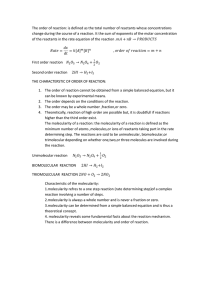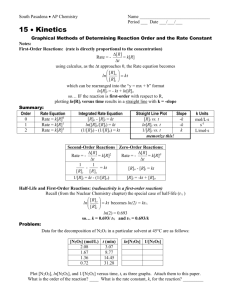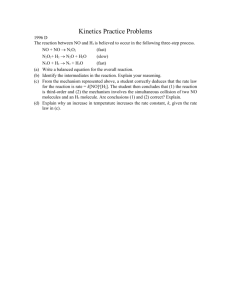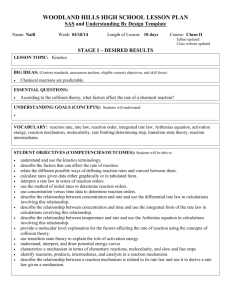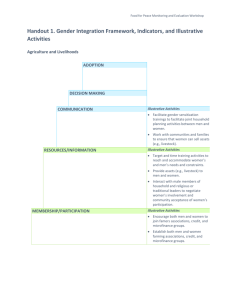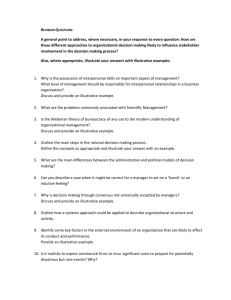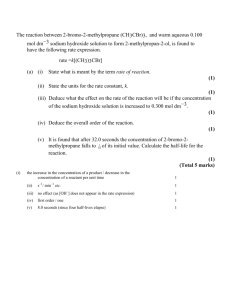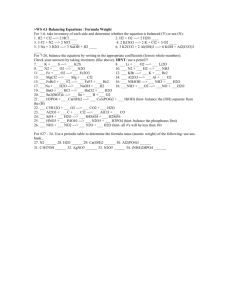46. Chemical Kinetics
advertisement
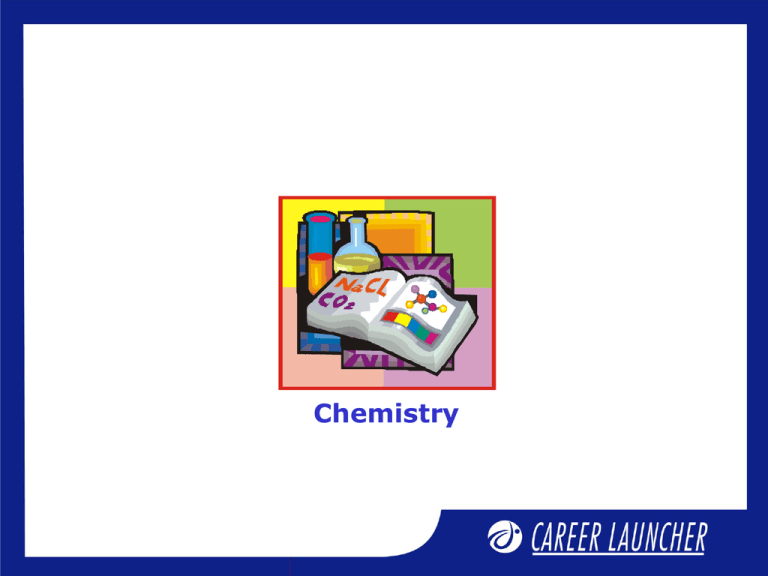
Chemistry Chemical Kinetics – 1 Session Objectives • Rate of reaction • Factors affecting rate constant • Molecularity • Order of a reaction • Kinetics of zero order reaction • Kinetics of first order reaction • Pseudo first order reaction Rate of reaction For a reaction, A B D The rate may be expressed as d[A] d[B] d[D] or or dt dt dt Change in the concentration of species Rate of reaction = Time int erval 1 1 Unit of rate of reaction = molL s Rate of reaction For general reaction aA bB cC dD Rate of reaction 1 d(A) 1 d(B) 1 d(C) 1 d(D) a dt b dt c dt d dt According to law of mass action Rate k A B a b Where k is rate constant. Rate constant Measure of rate of reaction Different for different reactions Independent of concentration of reactants Depends on the temperature Graphical representation of rate • The slope of graph at any instant gives us the rate of reaction at that moment and is called instantaneous rate of the reaction. • The average of these slopes over a period gives us rate of the reaction which is called as average rate of the reaction. Illustrative Example The reaction, 2N2O5(g) 4NO2(g) + O2(g), takes place in a closed container, it was found that the concentration of NO2 increases by 1.6 x 10-2 moles/litre in four seconds. Calculate the rate of the reaction and the rate of change of the concentration of N2O5. Solution: 2N2O5(g) 4NO2(g) + O2(g) rate of change of concentration of N2O5 d[N2O5 ] 1 d[N2O5 ] or = 2×rate 2 dt dt 1 d[NO2 ] 1 1.6×10-2 but rate = = × =1.0×10-3 molL-1 s-1 4 dt 4 4 d[N2O5 ] = 2×10-3 molesL-1 s-1 dt =- Rate law It is a mathematical expression that gives the true rate of reaction in terms of concentration of the reactants which actually influence the rate. Rate expression is experimentally determined. Consider a general reaction CH3 CHO(g) CH4 (g) CO(g) dCH4 dt 3/2 = k CH3CHO Molecularity For an elementry reaction, molecularity is the total number of molecules taking part in reaction. It has no significance for complex reaction Order of reaction The number of molecules which actually react and undergo a change in concentration is known as order of reaction. For example,the dissociation of N2O5 is a first order reaction 2N2O5 4NO2 O2 There can be a reaction of fractional order Consider a general reaction aA +bB cC + dD The rate law dx a b = k A B dt overall order = a + b Molecularity vs. Order Molecularity of Reaction Order of Reaction It is the number of atoms, ions or molecules that must collide with one another simultaneously so as to result into a chemical reaction. It is the sum of the power of concentration terms on which the rate of reaction actually depends or it is the sum of powers of the concentration terms in the rate law equation. Molecularity of reaction Cannot be zero. Order of reaction can be zero. It is a theoretical concept. It is determined experimentally. It is always a whole number. It can even have fractional values. The overall molecularity of complex reaction has no significance. Individual step has its own molecularity. Order of reaction is for overall reaction. Illustrative Example For a reaction, aA + bB + cC proucts, rate expression can be expressed as rate = k[A]1[B]-3/2[c]1/2, Write the order of the reaction with respect to ‘A’ , ‘B’, and ‘C’. What is the overall order of the reaction? Solution : Order of the reaction w.r.t. ‘A’ = 1 Order of the reaction w.r.t. ‘B’ = -3/2 Order of the reaction w.r.t. ‘C’ = 1/2 Overall order of the reaction = 1 + (-3/2) + 1/2 = 0 Illustrative Example The rate of the reaction, A P, increases by a factor of 5.18 when the concentration of A is tripled. What is the order of A? Solution: Assuming the order of the reaction w.r.t. ‘A’ is n, then the rate expression can be written as rate(rA ) = - d[A] = k[A]n dt rA n [A]1 1 = rA [A]2 2 rA n [A]1 1 or = 5.18rA 3[A] 1 1 or n = 1.5 Illustrative Problem For the reaction A+B Products The following initial rates were obtained at various given intial concentrations S. No [A] [B] Rate (mol lt–1 sec–1) 1. 0.1 0.1 0.05 2. 0.2 0.1 0.10 3. 0.1 0.2 0.05 Write rate law and find the rate constant of the above reaction. Solution - dx =k[A]'[B]o =k[A] dt Rate constant, k = 0.05 =5×10-1 s-1 0.1 Zero order reaction A Product Rate of reaction d[A] 0 = - k A dt where k = rate constant for zero order reaction d[A] = - k dt [A] =- kt + C When where C = Integration Constant. t = 0, then [A] =A0 hence C = A0 kt [A]0 [A] Zero order reaction Half life of a reaction :- Time taken for the reactant concentration to decrease to one half of its initial value Ao A = 2 k t1/2 = Ao t1/2 Ao = Ao = Ao 2 2 2k Half life a initial concentration Zero order reaction Half life a initial concentration t1 / 2 Initial concentration Concentration [A] Zero order reaction t1/2 dx dt Time 't' Initial conc. [A]0 t Graphical representation for zero order reaction on the basis of x = kt + C First order reaction A Product initial conc. a at time t (a x) - d[A] = k[A] dt a-x - 0 x a t d[A] d[A] = k dt dt 0 ln[A]a a-x = kt ln a = kt a- x Unit of rate constant is time-1 (mol / lit)1n time1 n order of reaction k 2.303 a log10 t (a x) First order reaction kt loga 2.303 Plot of (a x) vs t is a straight line k with slope 2.303 log(a x) When t t1 / 2 t1 / 2 0.693 k Half life of first order reaction does not depend upon initial concentration Amount of substance left after n half lives Ao 2n First order reaction For 75% completion of reaction 1 4 2.303 a x log t75% a/4 ax 2.303 log 4 t75% t75% 2t1 / 2 First order reaction log[A]o log [A] t Fig: Graphical representation for first order reaction Slope of line = - k 2.303 Illustrative Example For a first order reaction, A P, half life is 69.3 min. Calculate the time taken to decay the amount of ‘A’ to 80%. Solution: t1 / 2 69.3 min or t 0.693 t1 / 2 0.693 0.01min1 69.3 k k 2.303 100 log [ 80% reaction is complete] t 20 2.303 2 10 log5 160.97 min. Alternate Solution n 1 We know, Nt No 2 n no. of half life n 1 20 100 2 n 1 1 5 2 log n 1 1 nlog 5 2 0.699 2.322 0.301 time 2.322 69.3 160.9 min. Illustrative Example The half-life of a substrate in a certain enzyme-catalyzed first order reaction is 138 s. How long will it require for the initial concentration of substrate, which was 1.28 mmol/L, to fall to 0.040 mmol/L? Solution: t [A] 2.303 138 2.303 1.28 log 0 log k 0.693 0.040 [A] t 690 s Pseudo - first order reaction Reactions which are not truly of the first order but under certain conditions reactions become that of first order are called pseudo unimolecular reaction. For example: Hydrolysis of ester in presence of acid CH3COOC2H5 + H2O CH3COOH + C2H5OH From this reaction, the rate expression should be r = k [ester] [H2O] Since, hydrolysis takes place in the excess of H2O and concentration change of H2O is negligible practically. therefore, r = k’ [ester] Where k’ = k[H2O]. Thank you
